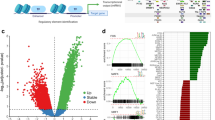Summary
The effects of epigenetic modification on the differentiation of islet cells and the expression of associated genes (Pdx-1, Pax4, MafA, and Nkx6.1, etc) were investigated. The promoter methylation status of islet differentiation-associated genes (Pdx-1, Pax4, MafA and Nkx6.1), Oct4 and MLH1 genes of mouse embryonic stem cells, NIH3T3 cells and NIT-1 cells were profiled by methylated DNA immunoprecipitation, real-time quantitative PCR (MeDIP-qPCR) techniques. The histone modification status of these genes promoter region in different cell types was also measured by using chromatin immunoprecipitation real-time quantitative PCR methods. The expression of these genes in these cells was detected by using real-time quantitative PCR. The relationship between the epigenetic modification (DNA methylation, H3 acetylation, H3K4m3 and H3K9m3) of these genes and their expression was analyzed. The results showed that: (1) the transcription-initiation-sites of Pdx-1, MafA and Nkx6.1 were highly methylated in NIH3T3 cells; (2) NIH3T3 cells showed a significantly higher level of DNA methylation modification in the transcription-initiation-site of Pdx-1, Pax4, MafA and Nkx6.1 genes than that in mES cells and NIT-1 cells (P<0.05); (3) NIT-1 cells had a significantly higher level of H3K4m3 modification in the transcription-initiation-site of Pdx-1, Pax4, MafA and Nkx6.1 genes than that in mES cells and NIH3T3 cells (P<0.05), with significantly increased level of gene expression; (4) NIH3T3 cell had a significantly higher level of H3K9m3 modification in the transcription-initiation-site of Pdx-1, Pax4, MafA and Nkx6.1 genes than that in mES cells and with NIT-1 cell (P<0.05), with no detectable mRNA expression of these genes. It was concluded that histone modification (H3K4m3 and H3K9m3) and DNA methylation might have an intimate communication between each other in the differentiation process from embryonic stem cells into islet cells.
Similar content being viewed by others
References
Arney KL, Fisher AG. Epigenetic aspects of differentiation. Cell Sci, 2004,117(19):4355–4363
Delcuve GP, Rastegar M, Davie JR. Epigenetic control. Cell Physiol, 2009,219(2):243–250
Quina AS, Buschbeck M, Di Croce L. Chromatin structure and epigenetics. Biochem Pharmacol, 2006, 72(11):15 632–15 669
Martin C, Zhang Y. The diverse functions of histone lysine methylation. Nat Rev Mol Cell Biol, 2005,6(11): 838–849
Zhang Y. Transcriptional regulation by histone ubiquitination and deubiquitination. Genes Dev, 2003,17(22):2733–2740
Margueron R, Trojer P, Reinberg D. The key to development: interpreting the histone code? Curr Opin Genet Dev, 2005,15(2):163–176
Thiriet C, Hayes JJ. Chromatin in need of a fix: phosphorylation of H2AX connects chromatin to DNA repair. Mol Cell, 2005,18(6):617–622
Razin A, Riggs AD. DNA methylation and gene function. Science, 1980,210(4470):604–610
Steimer A, Schöb H, Grossniklaus U. Epigenetic control of plant development: new layers of complexity. Curr Opin Plant Biol, 2004,7(1):11–19
Felsenfeld G, Groudine M. Controlling the double helix. Nature, 2003,421(1411): 448–453
Strahl BD, Allis CD. The language of covalent histone modifications. Nature, 2000,403(6765):4–5
Naya FJ, Stellrecht CM, Tsai MJ, et al. Tissue-specific regulation of the insulin gene by a novel basic helix-loop-helix transcription factor. Genes Dev, 1995, 9(8):1009–1019
Knepel W. Transcriptional control of pancreatic islet hormones gene expression. Exp Clin Endocrinol, 1993, 101(1):39–45
Santi DV, Garrett CE, Barr PJ. On the mechanism of inhibition of DNA-cytosine methyltransferases by cytosine analogs. Cell, 1983,33(1):9–10
Chavez L, Jozefczuk J, Grimm C, et al. Computational analysis of genome-wide DNA methylation during the differentiation of human embryonic stem cells along the endodermal lineage. Genome Res, 2010,20(10):1441–1450
Landolin JM, Johnson DS, Trinklein ND, et al. Sequence features that drive human promoter function and tissue specificity. Genome Res, 2010,20(7):890–898
Bradbury J. Human epigenome project up and running. PLoS Biol, 2003,1(3):E82
Klose RJ, Bird AP. Genomic DNA methylation: the mark and its mediators. Trends Biochem Sci, 2006,31(2):89–97
Arney KL, Fisher AG. Epigenetic aspects of differentiation. Cell Science, 2004,117(Pt 19):4355–4363
Kouzarides T. Histone acetylases and deacetylases in cell proliferation. Curr Opin Genet Dev, 1999,9(1):40–48
Litt MD, Simpson M, Gaszner M, et al. Correlation between histone lysine methylation and developmental changes at the chicken beta-globin locus. Science, 2001,293(5539):2453–2455
Johnson L, Mollah S, Garcia BA, et al. Mass spectrometry analysis of arabidopsis histone H3 reveals distinct combinations of post-translational modifications. Nucleic Acids Res, 2004,32(22):6511–6518
Vaissiere T, Sawan C, Herceg Z. Epigenetic interplay between histone modifications and DNA methylation in gene silencing. Mutat Res, 2008,659(1–2):40–48
Boyer LA, Plath K, Zeitlinger J, et al. Polycomb complexes repress developmental regulators in murine embryonic stem cells. Nature, 2006,441(7091):349–353
Loh YH, Wu Q, Chew JL, et al. The Oct4 and Nanog transcription network regulates pluripotency in mouse embryonic stem cells. Nat Genet, 2006,38(4):431–440
Author information
Authors and Affiliations
Corresponding author
Rights and permissions
About this article
Cite this article
Fang, A., Zhang, Y., Li, M. et al. Effects of DNA methylation and histone modification on differentiation-associated gene expression in ES, NIH3T3, and NIT-1. J. Huazhong Univ. Sci. Technol. [Med. Sci.] 31, 10–16 (2011). https://doi.org/10.1007/s11596-011-0142-8
Received:
Published:
Issue Date:
DOI: https://doi.org/10.1007/s11596-011-0142-8




